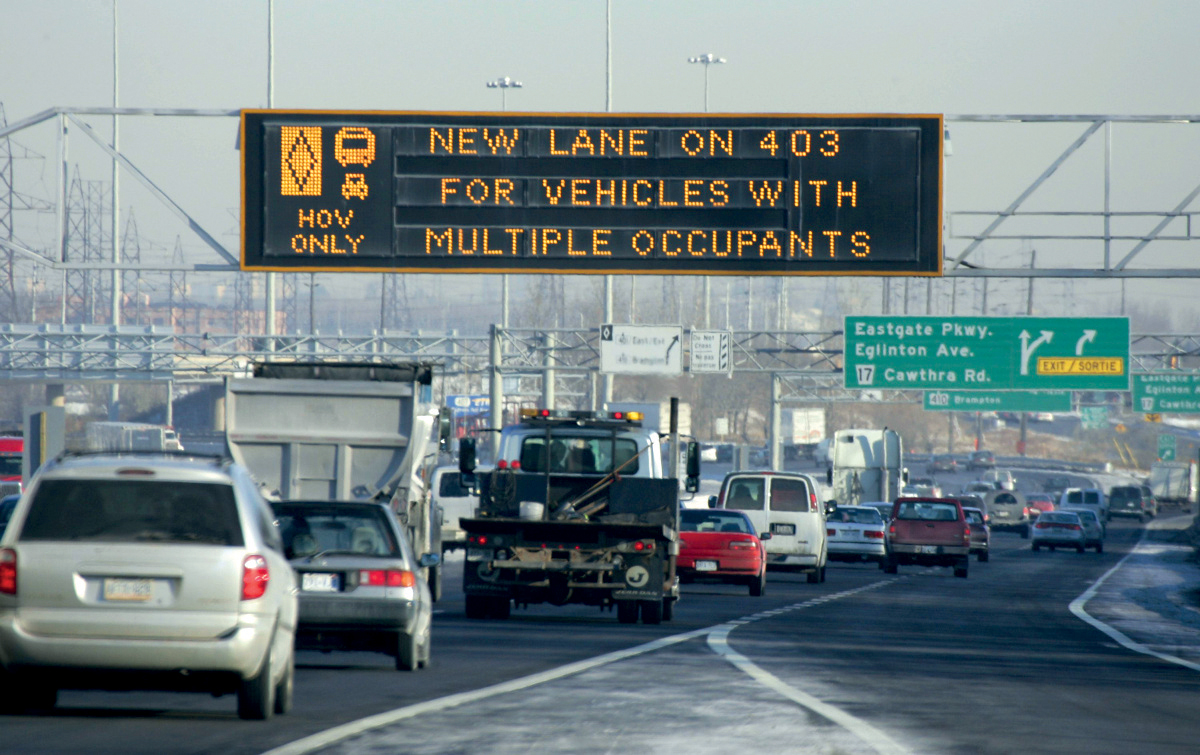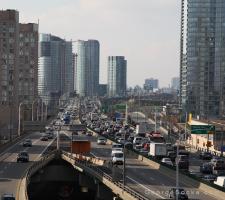
David Crawford sees an evidence-based approach to HOT lane conversions.
Canada’s first high occupancy toll (HOT) lanes opened on 16 September 2016 as a pilot on a 16.5km section of existing high occupancy vehicle (HOV) lanes running in both directions along Toronto’s Queen Elizabeth Way. Promised in two recent budgets, the pilot will help the province of Ontario’s Ministry of Transportation (MTO) decide on the most appropriate future technology for managing planned permanent installations.
A ministry request for information regarding potential electronic solutions closed on 22 August 2016, and attracted 19 submissions, proposing - among other options - Bluetooth connectivity, radio frequency identification and mobile apps. Trials are planned during 2017. An MTO spokesperson told ITS International: “We are closely monitoring the network performance and are already seeing the impact of adding this new user group. We will be testing potential solutions for viability for long-term implementation. As tolling technology is evolving rapidly, the MTO is committed to using an evidence-based approach.”
The MTO selected the route because it has the highest peak-hour availability of the three permanent HOV lanes in Greater Toronto.
It hopes that the concept, when fully developed and extended, will prove an ‘important source of revenue’, helping fund a 10-year strategy for reducing the severe traffic congestion plaguing the provincial capital and for increasing public transit use.
Running between two suburban communities south west of Canada’s largest city, the HOT lanes, are the first phase of a planned conversion of up to 85km of existing HOV lanes and up to 150km of former restricted access lanes introduced for the summer 2015 PanAmerican Games.
MTO is piloting a regime whereby vehicles with two or more occupants can use the HOT lanes without charge while sole drivers need to apply online for what will initially be a paper permit to display in the vehicle. Qualifying vehicles do not need permits to travel in the lanes.
The changed status of the lanes is being advised to motorists via portable Variable Message Signs (VMS).
Low-tech approach
The ministry has implemented this initially low-tech approach on the grounds that similar permits were used to allow access to the Games’ HOV lane network, and proved very successful. Several US jurisdictions, including the states of California and Utah, deployed similar permits at the early stages of their own HOT lane programmes, with Utah – the model for Toronto – converting to electronic charging in 2010.Permit holders have to agree to respond to the ministry’s electronic questionnaires and allow it to retain the resulting data. Drivers using other corridors are being surveyed separately.
One hoped-for result is an increase in carpooling, supported by a battery of online tools and apps, many developed for the Games.
Over the next two to four years, the MTO is issuing permits in batches of up to 1,000 a time. In August 2016, it received over 3,400 applications for an initial allocation of 500, at a unit cost of CAN$180 (US$135) for a three-month term, with applicants determined by random ballot. Holders can renew automatically only twice before needing to re-apply, in order to allow scope for fresh entrants to the scheme. For the second term, the MTO issued 332 new permits and 412 renewals (representing 82% of original applicants).
The spokesperson told ITS International: “We’ll be monitoring lane use and adjusting the permit volume accordingly. A three-month term provides users with a sufficient period of time to assess the value of the lanes. For the province, this timeframe allows for minor refinements each term.”
Wider network
The ministry is also using the information gathered to help it deliver a wider network of planned electronic HOT lanes, starting with a 15.5km stretch of Highway 427, Ontario’s second busiest freeway by volume and the third busiest in North America. This section is due to become operational by 2021.
In January 2017, the MTO announced the choice of the LINK 427 consortium as the preferred proponent for the extension and widening of Highway 427, with work due to begin after March 2017. The contract will include the building of the HOT infrastructure.
Highway 427 already carries high levels of express buses and has a major interchange with the Queen Elizabeth Way - an important feeder for the city’s Pearson International Airport and a link between Toronto and Buffalo, across the US border in New York State. The Queen Elizabeth Way, in turn, links at one end of its recently opened HOT lanes with the 108km Highway 407 express toll route (407 ETR), the first in the world to be electronically operated.
The present initiatives are all building on the experience of the 2015 Games, which saw large numbers of individual commuters opting for public transit in preference to using the slower non-HOV lanes. Because of the temporary HOV lanes, bus services by regional operator GO that had routinely been up to 20 minutes late before the Games, started to arrive on time or early. And there were also reports of canny lone pedestrians offering themselves for hire to commuters in order that they qualify to use the HOV lanes.
Organised carpooling had emerged in the forefront of pre-Games travel planning, with regional municipal transportation agency Metrolinx offering an online ‘smart commute’ tool for ride matching. Uber ran a two-week trial of its UberPool service during the Games and subsequently reintroduced it in January 2016.
Toronto-based start-up Blancride took advantage of the opportunity to spread awareness of its app.
Writing in the Toronto Star on 16 July 2015, Chris Ragan and Jessie Sitnick of Canada’s Ecofiscal Commission, which promotes strategies to combat climate change, commented: “All of this points to one thing: people are adjusting.” But the process of adjustment by drivers led to a sharp rise in crashes during the first week of the Games’ HOV operation. Police were unable to say how many incidents actually occurred on the HOV lanes, but commented that “if there’s a change in highway design, it can take a while for drivers to get used to it”. (The MTO spokesperson told ITS International: “To date, we have seen no increase in collisions as a result of the HOT lanes pilot”).
Undeterred, Ragan and Sitnick went on to ask: “So: what if it were possible to harness the innovation sparked by the lanes to take that experiment one step further? What if anyone could choose to use those faster lanes for a fee? What would we learn?”
Post Olympics
The answer came shortly afterwards when provincial premier Kathleen Wynne warned motorists who had been getting used to the temporary HOV lanes (which ceased operating after the Games) to prepare for the future HOT ones. The concept is also seen as being relevant to future bids for the city to host further international events such as a World Expo or summer Olympics, the need to create a site for which could regenerate the 356ha Port Lands stretch of former industrial waterfront.
Currently, Canada has some 35 HOV installations, the pioneers being the regions of Greater Toronto and Greater Vancouver (which is studying the current pilot with great interest).
The new HOT lanes already appear on the MTO’s Ontario 511 travel information website. Work is currently underway on a successor to a pilot route planner which it supported from 1 May 2016 to 31 December 2016, to capitalise on the MTO’s PanAmerican Games experience. This integrated information from both provincial and municipal highways, and transit agencies, in order to offer multi-modal route planning. It gave three options: ‘drive, ‘transit’ and ‘drive+transit’ (which provided road driving directions to transit hubs that offered parking).
It also put out email or SMS alerts on traffic incidents and travel times along chosen routes, and hands-free audible alerts via a mobile app. The MTO spokesperson told ITS International: “Information collected during the route planner pilot will be considered as the ministry moves forward with the modernisation of its broader traveller information services programme. Timelines are still to be determined.







